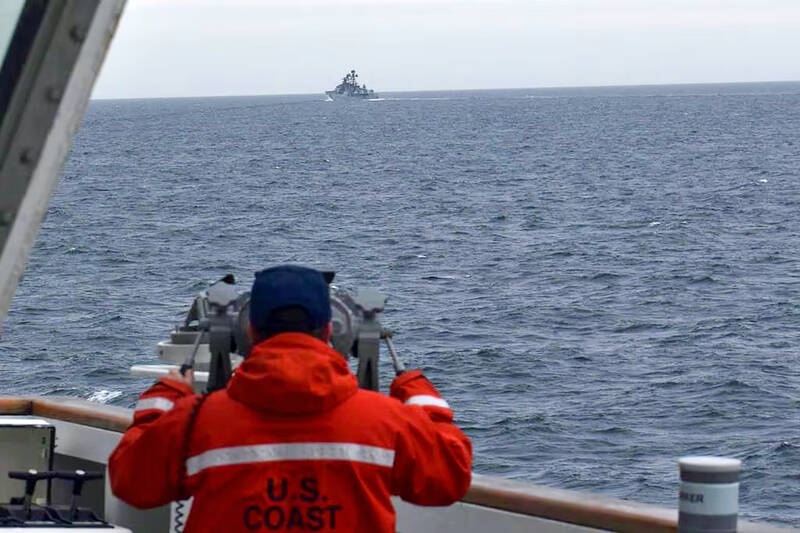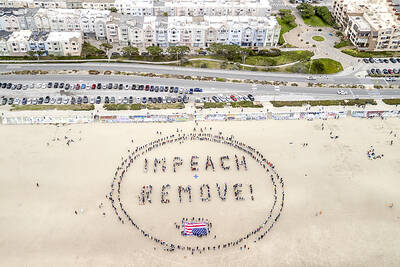A US Coast Guard cutter on routine patrol in the Bering Sea came across several Chinese military ships in international waters but within the US exclusive economic zone, officials said.
The crew detected three vessels about 200km north of the Amchitka Pass in the Aleutian Islands, the US Coast Guard said in a statement on Wednesday. A short time later, a helicopter aircrew from US Coast Guard Air Station Kodiak spotted a fourth ship about 135km north of the Amukta Pass.
All four of the Chinese People’s Liberation Army (PLA) vessels were “transiting in international waters but still inside the US Exclusive Economic Zone [EEZ],” which extends 370km from the US shoreline, the statement said. The PLA vessels told the coast guard their purpose for being there was “freedom of navigation operations.”

Photo: U.S. Coast Guard District 17 via AP
“The Chinese naval presence operated in accordance with international rules and norms,” Seventeenth Coast Guard District Commander Rear Admiral Megan Dean said. “We met presence with presence to ensure there were no disruptions to US interests in the maritime environment around Alaska.”
US Coast Guard Cutter Kimball is a 127m ship based in Honolulu. The US Coast Guard said there is no requirement for foreign nations to proactively contact a country before entering their EEZ and in this case said the Chinese vessels responded when the coast guard reached out on radio.
The US Coast Guard did not say how long the Chinese ships were in the EEZ, but said the Kimball and an aircrew monitored them until they transited south of the Aleutian Islands and into the North Pacific Ocean.
The sighting of the ships came a week after the PLA Navy began its annual joint patrol with the Russian Navy in the Pacific Ocean, the US Naval Institute reported on Friday last week. It said the patrol is scaled down from previous years, including August last year when more than 10 ships from China and Russia formed a flotilla off Alaska.
In September 2022, the Kimball spotted several ships from China and Russia in the Bering Sea, and in September 2021, US Coast Guard cutters in the Bering Sea and North Pacific Ocean encountered Chinese ships about 80km off the Aleutian Islands. The US Coast Guard said there was a similar incident last year that the Navy responded to.
“Our military needs to be ready for increasing Chinese, and joint Chinese and Russian military activity near Alaska’s coast,” US Senator Dan Sullivan said in a statement after being briefed on the Chinese presence.
“I also met yesterday morning with the chairman of the Joint Chiefs of Staff and specifically raised this issue — how America must be much more prepared for the increasing activity in the Arctic, and to also let Alaskans know that our military is on the job protecting our state and our country,” Sullivan said.
The US military routinely conducts what it calls freedom of navigation operations in disputed waters in Asia that China claims as its own, deploying Navy ships to sail through waterways such as the South China Sea. The US says freedom of navigation in the waters is in the US’ national interest.
When the Chinese vessels describe what they’re doing as “freedom of navigation operations,” it’s essentially China flexing its muscles by showing up in a part of the world that the US considers part of its sphere of influence, said Aaron Davenport, a retired senior coast guard officer and senior policy researcher at the RAND Corp.
He said it’s similar to how the US has deployed coast guard or other ships to the Taiwan Strait to uphold freedom of navigation and support US’ allies in the region — with the important distinction that the Aleutian Islands are clearly part of the US.

POLITICAL PRISONERS VS DEPORTEES: Venezuela’s prosecutor’s office slammed the call by El Salvador’s leader, accusing him of crimes against humanity Salvadoran President Nayib Bukele on Sunday proposed carrying out a prisoner swap with Venezuela, suggesting he would exchange Venezuelan deportees from the US his government has kept imprisoned for what he called “political prisoners” in Venezuela. In a post on X, directed at Venezuelan President Nicolas Maduro, Bukele listed off a number of family members of high-level opposition figures in Venezuela, journalists and activists detained during the South American government’s electoral crackdown last year. “The only reason they are imprisoned is for having opposed you and your electoral fraud,” he wrote to Maduro. “However, I want to propose a humanitarian agreement that

Young women standing idly around a park in Tokyo’s west suggest that a giant statue of Godzilla is not the only attraction for a record number of foreign tourists. Their faces lit by the cold glow of their phones, the women lining Okubo Park are evidence that sex tourism has developed as a dark flipside to the bustling Kabukicho nightlife district. Increasing numbers of foreign men are flocking to the area after seeing videos on social media. One of the women said that the area near Kabukicho, where Godzilla rumbles and belches smoke atop a cinema, has become a “real

‘POINT OF NO RETURN’: The Caribbean nation needs increased international funding and support for a multinational force to help police tackle expanding gang violence The top UN official in Haiti on Monday sounded an alarm to the UN Security Council that escalating gang violence is liable to lead the Caribbean nation to “a point of no return.” Special Representative of the UN Secretary-General for Haiti Maria Isabel Salvador said that “Haiti could face total chaos” without increased funding and support for the operation of the Kenya-led multinational force helping Haiti’s police to tackle the gangs’ expanding violence into areas beyond the capital, Port-Au-Prince. Most recently, gangs seized the city of Mirebalais in central Haiti, and during the attack more than 500 prisoners were freed, she said.

DEMONSTRATIONS: A protester said although she would normally sit back and wait for the next election, she cannot do it this time, adding that ‘we’ve lost too much already’ Thousands of protesters rallied on Saturday in New York, Washington and other cities across the US for a second major round of demonstrations against US President Donald Trump and his hard-line policies. In New York, people gathered outside the city’s main library carrying signs targeting the US president with slogans such as: “No Kings in America” and “Resist Tyranny.” Many took aim at Trump’s deportations of undocumented migrants, chanting: “No ICE [Immigration and Customs Enforcement], no fear, immigrants are welcome here.” In Washington, protesters voiced concern that Trump was threatening long-respected constitutional norms, including the right to due process. The